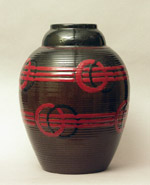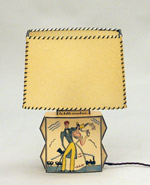|
The Mystery of the great fire These few lines cannot hope to relate the industries and patient efforts of the potters and ceramists. They mean to be only an initiation to the mystery of the great fire. Though improved as it is nowadays, by the recent discoveries made by chemical and physics, the art of ceramics is always closely attached to the earth from where it comes. The first necessary element for the potter, is the millenary clay; crushed and purified, it lets itself be modeled by the fingers of the turner. The loaf of earth becomes round, then the shape begins to arise, it springs, it sinks, the molecules tighten; on the wheel tray the frail vessel to which the potter's fingers give a last stoke, seems to quiver before it immobilises itself, and leaves the wheel where it was given birth. Or, obliged to go through the finest sieve, the argillous mud, of which clever mixing composed the texture, is put in a plaster mould which gives in the most variegated shapes, from the ordenary rustic pot, on which wonderfully colored flowers will be painted, to the lovely slim vase of which the enamels will be the sole ornament.
On the drying boards the ceramist chooses a form, a frail and thin crust of earth. Then among the oxyds, he takes the powders which he mixes in order to obtain a liquid paste which his brushes leave, touch by touch, on the vase. With his imaginative mind, he paints arabesques, or flowers, or inlays chimeras on the cups, the amphoras or the dishes. From the ordinary glazed earth bathed in enamel to the decorated vase, his technic makes of him an ordinary potter or a great ceramist. Day after day, for weeks of hard work, he tries never to make the same pattern. Before he puts the result of his work in the oven, he makes other tests, a new oxyd, an enamel never used before, trying to make a new sucess of a more delicate colour. To intrust the minute work of several months, the hopes which represent new enamels, to this unconquered element which is the fire at a high temperature. Same as a medieval dingeon, the oven deeply set in the ground shall then receive in it’s caskets, of refractory earth, the vases of different shapes, the frail statuettes. One after the other the caskets are piled up to the vault. Then there ist only to wall up the door and to screw the steeled keys which will hold the oven shut during the baking. For several days the oven ist cooling down. Hours of feverish expectation, hours of hope and of anguish. At last the door is opened. With his hands gloved with muffles, the ceramist takes away the burning caskets, and then the unique pieces come to the light: Copper red with warm tons, celadon-green, reddish-brown, black or simple statuettes of which the fire has respected the rustic or delicate shapes; unchangeable and majestic witnesses even in their modesty. They are the reward of long months of arduous labor during which they unite the work of the hands with the efforts of the intelligence. From the humble potter to the genial ceramist, handicraftsmen and artists of today are united to the old eastern masters and the great medieval painters by a common love: that of the fire. Jean Mougin
|
| back |
 Those forms out of the potter’s hands or out of the moles, are waiting in their nakedness until the water contained in the clay is evaporated. The nature itself of the earth, which has been used determines the different kinds of pottery and their names: stanniferous earthenware, hard or soft porcelain, stoneware. The composition of the enamels which are going to cover them, and the degree of heat to which they will be submitted in the oven, help to discriminate glazed earth, crackled earthenware, flamed stoneware and stoneware of great fire. The artist, though, is preparing his oxyds. After having been a potter, and before he becomes a decorator and painter, he becomes a chemist and sometimes even an alchimist. As it is now a matter of using only a palett with essential colours, but, by means of clever mixtures, to prepare the oxyds, to crush them, to knead them, to study, before covering the vase with them their reaction under the different temperatures. Copper gives reds and greens; cobalt, blues; uranne and antimony, yellow; manganese and lead, black. A deep knowledge of their degree of melting, and the combination of one with the others, is necessary before any artistic effect, to obtain the chemical success, for ceramic, the intimate cooporation of the man’s genious, and of the magic strength of the fire, one close union of the human brain, of the raw material, and of a capricious strength: the fire.
Those forms out of the potter’s hands or out of the moles, are waiting in their nakedness until the water contained in the clay is evaporated. The nature itself of the earth, which has been used determines the different kinds of pottery and their names: stanniferous earthenware, hard or soft porcelain, stoneware. The composition of the enamels which are going to cover them, and the degree of heat to which they will be submitted in the oven, help to discriminate glazed earth, crackled earthenware, flamed stoneware and stoneware of great fire. The artist, though, is preparing his oxyds. After having been a potter, and before he becomes a decorator and painter, he becomes a chemist and sometimes even an alchimist. As it is now a matter of using only a palett with essential colours, but, by means of clever mixtures, to prepare the oxyds, to crush them, to knead them, to study, before covering the vase with them their reaction under the different temperatures. Copper gives reds and greens; cobalt, blues; uranne and antimony, yellow; manganese and lead, black. A deep knowledge of their degree of melting, and the combination of one with the others, is necessary before any artistic effect, to obtain the chemical success, for ceramic, the intimate cooporation of the man’s genious, and of the magic strength of the fire, one close union of the human brain, of the raw material, and of a capricious strength: the fire. At daybreak, the fire is set on. In holes made for such a purpose, locks of dry wood are piled up and set aflame, and the inside temperature slowely increases up to 800 degrees centigrade – first phase of the baking. Little by little, all the dampness that was left evaporates. The chill ist taken of the pieces, and by this initiation through the fire, they are ready to receive the burning caress of the flames which, for chinaware and stoneware shall bring the temperature up to 1300 degrees centigrade. Long hours of baking during which the special holes, in a terrific roaring, claim more and more wood. The least of weakness – a too quickly rising of the heat or an unexpected fall – may ruine the whole batch, transforming the expected works of art in a hip of unshaped vases which the flames will throw one against the other, and the ornament of which shall only be a swollen crust. Today, the improved technic of ovens and the means of control do not allow many such accidents, and it allows also the ceramist to run his fire which, though burning, can be directed. By means of dormer-windows set in the oven walls, the ceramist can, in observing the melting of what is called the witness-clocks, follow the rise of the degrees. When the last witness-clock falls, the hole for the wood is shut, and the flames looking for a way out go into the high chimney. The work of the artist is at an end.
At daybreak, the fire is set on. In holes made for such a purpose, locks of dry wood are piled up and set aflame, and the inside temperature slowely increases up to 800 degrees centigrade – first phase of the baking. Little by little, all the dampness that was left evaporates. The chill ist taken of the pieces, and by this initiation through the fire, they are ready to receive the burning caress of the flames which, for chinaware and stoneware shall bring the temperature up to 1300 degrees centigrade. Long hours of baking during which the special holes, in a terrific roaring, claim more and more wood. The least of weakness – a too quickly rising of the heat or an unexpected fall – may ruine the whole batch, transforming the expected works of art in a hip of unshaped vases which the flames will throw one against the other, and the ornament of which shall only be a swollen crust. Today, the improved technic of ovens and the means of control do not allow many such accidents, and it allows also the ceramist to run his fire which, though burning, can be directed. By means of dormer-windows set in the oven walls, the ceramist can, in observing the melting of what is called the witness-clocks, follow the rise of the degrees. When the last witness-clock falls, the hole for the wood is shut, and the flames looking for a way out go into the high chimney. The work of the artist is at an end.